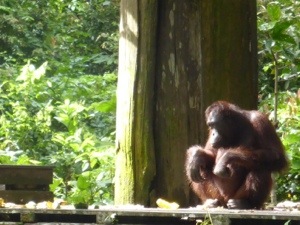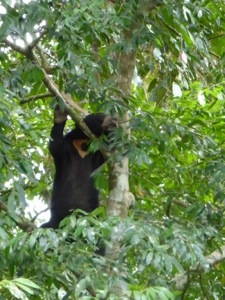Travelling through Peninsula Malaysia from Thailand I was struck by the attention paid to the roadside. Flowers and greenery which had been planted along the verges. It all looked very ‘looked after’ and ordered. The roads, mostly, were wide and free flowing, well maintained and a far cry from the ‘massage roads’ of Cambodia and Java.
The second thing I noticed was the palm trees. Vast stretches as far as the eye could see. Palm tree plantations. One of the most frightening sights I have seen. Almost for the entire journey the length of Malaysia, from Southern Thailand into Singapore, and from Kota Kinabalu to Sandakan (Borneo) it was almost completely lined by these plantations. Having a little understanding of the dwindling rain forests and the implication on wildlife is one thing, but seeing it, not just on the peninsula but also throughout Sabah (Malaysian Borneo) it is truly upsetting. Eighty percent of the rain forest has been destroyed.

Palm oil plantation, Malaysia (Louise Kenward, 2014)
My attempt to learn more from the guide in Borneo proved a fairly fruitless task. He rattles off how the main industry in Sabah is palm oil and rubber, followed by petrol and tourism. Palm oil is big business. I am told that the palm oil plantations have ‘only’ been created in existing secondary forest, rubber plantations (replaced as rubber has lost its value). The difference being that palm oil plantations are silent.
Nothing can live in these deserts. There is no food or habitat for wildlife. Sepilok is home to three animal sanctuaries, Orang utan rescue (a UK charity), Proboscis Monkey Sanctuary and Sun Bear Conservation (recently opened). These are programmes developing in response to the dwindling forests. Orang utans have been rescued from palm oil plantations desperately looking for food. The work of the charity also includes educating locals how taking baby orang utans for pets is illegal, raising babies who have been taken as pets and teaching them how to be wild again. The balance of conservation and tourism is a fine one. Dedicated protected forests are the home of these organisations. During rehabilitation orang utans have their diet supplemented by the centre which provides food twice a day at platforms which visitors can view. We stand silently watching the ropes move and trees and branches sway, as orang utans make their way through the forest. There are only a handful likely to arrive, many living wild further afield or still not ready for this phase in the programme. One adult female orang utan arrives, swinging around the platform to assess the bounty and grabs a handful of bananas and starts to munch. A macaque monkey joins her and tries to wrestle them off her. She swings from one of the ropes and is joined by two more, one very small one just three or four years old. The dynamics and characters of each creature and their relationships with one another is fascinating to watch. The volunteer tells me a bit about them, how the smallest was rescued without her mother (they generally do not leave their mothers until they reach the age of about 10). She has taken to one of the adult females and more recently had started following a second as well. Watching her learn as she copied the older one, feeding and climbing. There are only 20,000 left in the wild, 200 are here in Sepilok. ‘Men of the Forest’ they share 96.4% of our genetics (particularly interesting in the wake of this recent National Geographic article).

Orang utan Rescue UK, Sepilok (Louise Kenward, 2014)
The previous day I had been fortunate enough to witness several orang utans in the wild. A boat trip along Kinabatangan River saw proboscis monkeys, orang utans, hornbills and elephants. These were rare sightings and magnificent to witness even if fleetingly and from some distance. There are apparently ropes across the river enabling orang utans to cross from one side to another, but again there are large portions of land dedicated to palm oil. Throughout my journey I have only once seen any information about palm oil, a WWF poster on a bus stop in Singapore warned of the wider impact that our consumption of palm oil is having. It’s used everywhere, in edible and non edible industries, cosmetics, soap, foods. Mc Donald’s is not surprisingly a major consumer. I pledge to read labels more carefully.

Sun bear (honey bear) sanctuary, Sepilok (Louise Kenward, 2014)

Proboscis Monkey Sanctuary (Louise Kenward, 2014)






